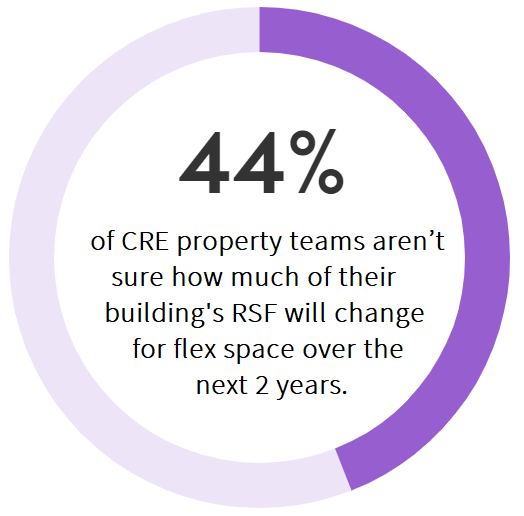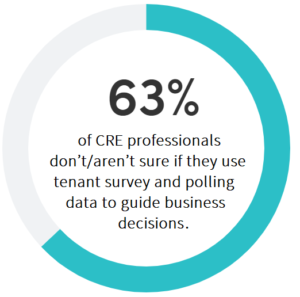The past few years have impacted the commercial real estate (CRE) industry ten times over. It’s become increasingly apparent that property teams’ focus has fully shifted to their tenants. And tenant improvements commercial property teams have had to make have been no small feat either.
We met with three CRE industry experts in our recent webinar, “What’s in Store for CRE Buildings Operations in 2023,” to discuss the latest commercial real estate trends and, more specifically, this year’s focus on tenant experience and the evolving workplace.
Panelists included:
- Tim Curran, Executive Managing Director, Property & Asset Management Technologies, Building Engines/JLL Technologies
- Greg Carey, Senior VP and Chief Information Officer, The RMR Group
- Randy Fink, Managing Director, Property & Asset Management, JLL
Here are three ways buildings can expect to change to meet new tenant needs and what CRE teams can do to adapt.
1. Maintaining Buildings that Support a Hybrid Work Model
Even with the pandemic slowing down, many tenants are still choosing to work remotely or opt for a hybrid work model. According to The State of Commercial Real Estate Building Operations for 2023, 84% of CRE teams say at least some of their tenants are using a hybrid work model. Not only are CRE teams having to adjust building layouts to meet new requirements, but they are also having to find ways to encourage tenants to leave the comforts of home and commute back to their buildings instead.
This has made it tricky for property teams to find a balance between keeping their buildings up and running and providing a safe and inviting environment for tenants – all while maintaining their budget.
“One of the challenges is just because the building isn’t being 100% utilized and occupied, doesn’t mean you cannot operate that building on a given day. We are working towards how to optimize buildings that are not fully utilized,” Carey said.
“Making sure the connectivity in the building and building amenities are in line with or make it worthwhile for tenants to come into the office versus just staying at home,” he added.
JLL’s Fink agreed. “For property managers the biggest issue is planning ahead, specifically with budgeting,” he said. “Planning ahead and adapting to that new normal from a spend perspective and a sourcing perspective is tricky because the new normal hasn’t really settled in yet.”
So, for this year, CRE teams will need to run their buildings in a way that works for their budget and operations while also accommodating their tenants. Why? Because the hybrid work model is not going anywhere, so property teams must optimize hybrid office usage as best they can.
2. Adapting Spaces to Accommodate Flex Space Needs
Flex space, defined as any commercial real estate that offers a space for multipurpose workplaces to meet business needs, has become increasingly popular at CRE properties. With this, landlords are looking for new ways to utilize and draw additional revenue from their buildings as they face the possibility of shrinking leases and diminished renewals. However, 44% of CRE property teams aren’t sure how much of their building’s rentable square footage (RSF) will change to accommodate flex space over the next two years, according to The State of Commercial Real Estate Building Operations for 2023.
So, is flex space an opportunity for landlords?
“We don’t know what the new normal is going to be,” Curran said. “Most customers are not in the flex space business. [So, tenants must think], ‘How do I staff? How do I change my thinking? How do I lease the space? What do contracts look like?’ You have a lot of differences with flex.”
Curran added: “We are thinking ahead to what our clients are going to need. And we are trying to build those solutions that we will be ready to convert their space, manage it, and doing a good job making it commute worthy as well.”
Flex space is still new and different for both CRE teams and tenants alike. However, there are technology solutions available for flex space management and for general space management as well. These building solutions will make it easier for property teams to meet each individual tenant’s needs.
3. Updating Your Building’s Tenant Engagement Strategy
Tenant engagement at CRE properties is an all-time focus for property teams now. But the way in which property teams are communicating with tenants might need to shift – because tenants have new needs and demands from their buildings.
“This is huge and it’s a fundamental disruption in our business in some ways. It’s still unfolding as we are understanding it,” Fink said when asked about the evolution of tenant engagement.
“Consumerization of commercial real estate is one of the biggest trends that has evolved and it’s changing our industry,” Fink added. “Over the last few years, we have seen an evolution really reach its apex. Where now, every individual that walks into a space is part of an echo chamber that’s helping make the decision for a tenant’s ultimate leasing renewal or expansion. The importance, the criticality of property manager’s customer service, and the focus on customer experience, is important in a way that it hasn’t been before.”
CRE teams must evaluate their tenant engagement strategy. And this includes reconsidering how they communicate with tenants – through a tenant experience app, for instance. For instance, research from The State of Commercial Real Estate Building Operations for 2023 showed 63% of CRE professionals don’t use or aren’t sure if they use tenant survey and polling data to guide business decisions, missing a huge opportunity to improve tenant satisfaction.
“With tenant experience apps you are going to be able to infer a lot about, do they like the amenities? Do they not? You are going to have a lot of data to make decisions around,” Curran said. “It’s not an annual survey that we are used to doing in our industry; it’s a more continuous survey that you can do, and you should be doing to really keep a pulse on what’s going on. Again, always trying to make that building commute worthy depending on what’s happening.”
With mobile apps built specifically for building communication and tenant experience, there leaves less room for communication disruption, tenant concerns, etc. Plus, data collected through the apps can be used to make insightful decisions about your buildings such as what amenities are most used, what spaces tenants occupy most frequently, and more.
Opportunity for 2023: Tenant Improvements Commercial Property Teams Can Capitalize On
Shifting tenant wants and needs need to be top of mind for CRE property teams this year. So, with the new year underway, it is best for property teams to lean into the opportunities by rethinking their current tenant experience strategy. Thankfully, there are tangible solutions for CRE teams –whether that is redesigning your building’s layout, including new amenities, or using mobile app technology to better engage with tenants.
Learn more from the by watching the on-demand webinar, “What’s in Store for CRE Building Operations in 2023.”


















